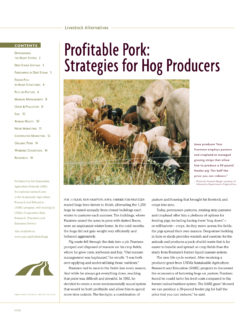Raising pork organically (and marketing it that way) presents another profitable niche. In 2000, USDA announced the final standards for organically grown agricultural products, including practices that can be used in producing and handling organic livestock.
Organic meats appear to be part of a growing niche market. While organic food makes up a small share of retail sales, it is growing by about 24 percent a year. The Food Marketing Institute, an organization representing food retailers and wholesalers, found that 37 percent of consumers look for and purchase products labeled as organic.
All agricultural products labeled 'organic' must originate from farms or handling operations certified by a state or private agency accredited by USDA. Farms and handling operations that sell less than $5,000 of organic products per year are exempt from certification. Animals for slaughter must be raised under organic management from the last third of gestation. Producers are required to use certified organic feed, but they may provide vitamin and mineral supplements.
Organically raised animals must not be given hormones or antibiotics. If an animal is sick or injured, producers must not withhold treatment, even if that means administering antibiotics and selling the meat on the conventional market. All organically raised animals must have access to the outdoors, and be confined only for health, safety or stage of production reasons, or to protect soil or water quality.
For more information about organic pork production, see 'Resources'.
Taste
Pork produced from pigs raised on deep bedding proved tastier than pork from confinement animals, a study at Texas Tech University found. They compared pork loins from a large swine operation that raises pigs on slatted floors versus 20 pork loins in a deep-bedding system, measuring responses from a trained sensory panel. Results, published as an abstract in the Journal of Animal Science, indicated that pigs housed on bedding produced pork that was juicier and better tasting. Moreover, carcasses from the deep-bedded group had a lower trim loss -- 5.8 percent compared to 14.9 percent for the group raised on slats.
'Historically, consumers' desires have been fairly simple -- to have cheap but wholesome food,' said John McGlone, head of Texas Tech's Pork Industry Institute. 'Now a large segment of consumers is demanding new requirements from the meat they buy.'
